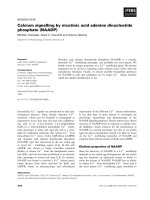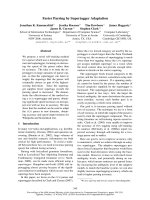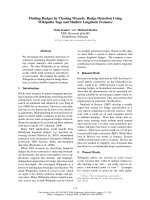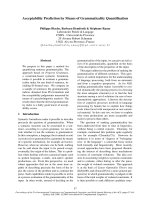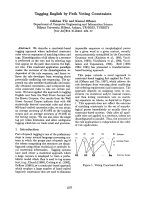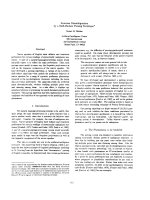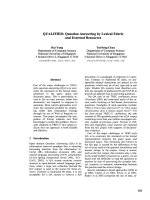Báo cáo khoa học: " Differential protection by wildtype vs. organelle-specific Bcl-2 suggests a combined requirement of both the ER and mitochondria in ceramide-mediated caspase-independent programmed cell death" docx
Bạn đang xem bản rút gọn của tài liệu. Xem và tải ngay bản đầy đủ của tài liệu tại đây (1.06 MB, 9 trang )
BioMed Central
Page 1 of 9
(page number not for citation purposes)
Radiation Oncology
Open Access
Research
Differential protection by wildtype vs. organelle-specific Bcl-2
suggests a combined requirement of both the ER and mitochondria
in ceramide-mediated caspase-independent programmed cell
death
Andrea Deerberg
1
, Justyna Sosna
1
, Lutz Thon
1
, Claus Belka
2
and
Dieter Adam*
1
Address:
1
Institut für Immunologie, Christian-Albrechts-Universität Kiel, 24105 Kiel, Germany and
2
Klinik und Poliklinik für Strahlentherapie und
Radioonkologie, Ludwig-Maximilians Universität München, 81377 München, Germany
Email: Andrea Deerberg - ; Justyna Sosna - ; Lutz Thon - ;
Claus Belka - ; Dieter Adam* -
* Corresponding author
Abstract
Background: Programmed cell death (PCD) is essential for development and homeostasis of
multicellular organisms and can occur by caspase-dependent apoptosis or alternatively, by caspase-
independent PCD (ciPCD). Bcl-2, a central regulator of apoptosis, localizes to both mitochondria
and the endoplasmic reticulum (ER). Whereas a function of mitochondrial and ER-specific Bcl-2 in
apoptosis has been established in multiple studies, corresponding data for ciPCD do not exist.
Methods: We utilized Bcl-2 constructs specifically localizing to mitochondria (Bcl-2 ActA), the ER
(Bcl-2 cb5), both (Bcl-2 WT) or the cytosol/nucleus (Bcl-2 ΔTM) and determined their protective
effect on ceramide-mediated ciPCD in transiently and stably transfected Jurkat cells. Expression of
the constructs was verified by immunoblots. Ceramide-mediated ciPCD was induced by treatment
with human recombinant tumor necrosis factor and determined by flow cytometric measurement
of propidium iodide uptake as well as by optical analysis of cell morphology.
Results: Only wildtype Bcl-2 had the ability to efficiently protect from ceramide-mediated ciPCD,
whereas expression of Bcl-2 solely at mitochondria, the ER, or the cytosol/nucleus did not prevent
ceramide-mediated ciPCD.
Conclusion: Our data suggest a combined requirement for both mitochondria and the ER in the
induction and the signaling pathways of ciPCD mediated by ceramide.
Background
The survival and homeostasis of multicellular organisms
critically depends on programmed cell death (PCD) to
correctly remove cells that are potentially harmful or
which have fulfilled their function. Although caspase-
dependent apoptosis, the most well-studied form of PCD,
represents the principal suicide program in most physio-
logical settings [1], many cells have the ability to commit
suicide by caspase-independent modes of PCD (ciPCD)
[2]. ciPCD fulfills vital functions in processes such as the
Published: 9 October 2009
Radiation Oncology 2009, 4:41 doi:10.1186/1748-717X-4-41
Received: 22 August 2009
Accepted: 9 October 2009
This article is available from: />© 2009 Deerberg et al; licensee BioMed Central Ltd.
This is an Open Access article distributed under the terms of the Creative Commons Attribution License ( />),
which permits unrestricted use, distribution, and reproduction in any medium, provided the original work is properly cited.
Radiation Oncology 2009, 4:41 />Page 2 of 9
(page number not for citation purposes)
negative selection of lymphocytes, the termination of
immune responses, embryonic removal of interdigital
webs, regulation of bone growth, ovulation, and cellular
turnover in the intestine [3]. Furthermore, ciPCD has
been implicated the pathology of hyperacute shock [4],
pancreatitis [5,6], cerebral and myocardial ischemia-
reperfusion injury, epilepsy, Alzheimer's disease and
other inflammatory injuries, as well as in the destruction
of cells by pathogens such as HIV, vaccinia virus, Shigella
and Salmonella [3,7]. In contrast to apoptosis, the molec-
ular mechanisms of ciPCD are just beginning to be
unraveled, e. g. by the recent identification of RIP3,
enzymes of the energy metabolism, Nox1, CYLD, Bmf,
and cathepsin and calpain proteases as candidate media-
tors of ciPCD [2,8-10]. However, and despite these
advances, a coherent picture of the molecular steps in
ciPCD is still lacking.
Mitochondria have been identified not only as essential
elicitors of apoptosis, but also of ciPCD, e.g. by release of
proteins such as AIF, EndoG and HtrA2/OMI, as well as by
production of reactive oxygen species (ROS) [2,11-13]. It
has been proposed that excess formation of ROS triggers
ciPCD by activation of the DNA repair enzyme PARP, fol-
lowed by intracellular depletion of NAD
+
and ATP,
nuclear translocation of AIF and finally, death [14]. Simi-
lar to mitochondria, the endoplasmic reticulum (ER) - as
the main site for critical cellular functions such as protein
folding, lipid biosynthesis, and calcium storage in the cell
- has also been implicated in the induction of both apop-
tosis [15] and ciPCD [2,12,13]. In fact, the ER may play a
key role in certain types of ciPCD, as intracellular calcium
influx caused by ER stress induces activation of calpains, a
family of calcium-dependent cytosolic proteases that can
elicit ciPCD [2].
Members of the Bcl-2 family of proteins have long been
recognized as central regulators of mitochondrial apopto-
sis, primarily by controlling the permeabilization of the
outer mitochondrial membrane [15]. They have also been
found localized at the ER, where they regulate apoptosis
in response to a range of cellular stresses, and also in the
nucleus [15], where they may fulfill yet unknown func-
tions. Similar to the established protective functions of
mitochondrial Bcl-2, expression of Bcl-2 at the ER has
been shown to protect cells from apoptosis, e. g. by regu-
lating the release of proapoptotic calcium, reducing cal-
cium-uptake by mitochondria and subsequent calpain-
dependent apoptosis [15]. The role of Bcl-2 in mitochon-
drial vs. ER-mediated apoptosis has been further
addressed in a number of studies by the use of Bcl-2 con-
structs that specifically localize to mitochondria or to the
ER [16-23]. In these studies, Bcl-2 localizing to the ER was
shown to interfere with apoptosis induction by some (c-
myc overexpression, etoposide, staurosporine, tunicamy-
cin, brefeldin A, ceramide, ionizing radiation, thapsi-
gargin, Bax, Bad) but not all stimuli (reviewed in [24,25]).
In contrast to this relative wealth of available data on
apoptosis, the role of ER- vs. mitochondrially localized
Bcl-2 in ciPCD has not been investigated so far. Here, we
utilize ciPCD elicited by ceramide as a model system, a
lipid second messenger that has been recognized as
important in radiation-induced elimination of tumor
cells [26,27]. We demonstrate for the first time that in
contrast to wildtype Bcl-2, restricted expression of Bcl-2
solely at mitochondria-, the ER-, or the cytosol/nucleus is
insufficient to prevent ciPCD. Therefore, our data suggest
a combined requirement of mitochondria and the ER in
ceramide-mediated ciPCD and implicate the existence of
a molecular crosstalk between both organelles.
Methods
Reagents and constructs
Highly purified human recombinant TNF (hTNF) was
supplied by BASF Bioresearch. Benzyloxycarbonyl-Val-
Ala-Asp-fluoromethylketone (zVAD-fmk) was obtained
from Bachem. Cycloheximide (CHX) was purchased from
Sigma. Expression constructs cloned in the vector pRc/
CMV (Invitrogen) encoding wildtype Bcl-2 (Bcl-2 WT),
cytosolic Bcl-2 lacking the transmembrane domain (Bcl-2
ΔTM) and Bcl-2 mutants restricted to the outer mitochon-
drial membrane (Bcl-2 ActA) or to the endoplasmic retic-
ulum (Bcl-2 cb5) were kindly provided by B. Leber
(McMaster University, Hamilton, Canada).
Cell culture and transfections
Wildtype human leukemic Jurkat cells were originally
obtained from the American Type Culture Collection. Jur-
kat cells stably transfected with the plasmid pSFFV-Bcl-2,
overexpressing full length human Bcl-2 at levels 10-20-
fold over untransfected cells [28] were kindly provided by
S. Korsmeyer (Harvard Medical School, Boston, USA).
Cells were maintained in a mixture of Click's/RPMI 1640
(50/50% v/v) supplemented with 10% v/v FCS, 2 mM
glutamine and 50 μg/ml each of streptomycin and penicil-
lin in a humidified incubator containing 5% w/v CO
2
.
Transient transfections of wildtype Jurkat cells were per-
formed by Amaxa nucleofection (Lonza Cologne), using
solution V and program C-16. Jurkat cells stably express-
ing the various versions of Bcl-2 in pRc/CMV were
obtained by electroporation using a Gene pulser II (Bio-
Rad) followed by selection with Geneticin (Invitrogen)
and were used as pool transfectants.
Caspase assays
Cells were lysed in a buffer containing 10 mM Hepes pH
7.4, 142 mM KCl, 5 mM MgCl
2
, 1 mM EGTA, 0.2% v/v
NP40, 1 mM DTT and 2 mM Pefabloc. To generate posi-
tive controls for activation, cytosolic extracts of untreated
cells were equilibrated for 1 h at 30°C after the addition
Radiation Oncology 2009, 4:41 />Page 3 of 9
(page number not for citation purposes)
of 1 mM dATP and 10 μM cytochrome c to permit activa-
tion of caspases and subsequent cleavage of substrate pro-
teins. To measure caspase activity, 100 μl of caspase buffer
(20 mM Pipes, 100 mM NaCl, 10 mM DTT, 1 mM EDTA,
0.1% w/v CHAPS, 10% w/v sucrose, pH 7.2) containing
100 μM zDEVD-afc or zIETD-afc (Calbiochem) were
added to 5 μl of cytosolic extract (50 μg protein) and incu-
bated at 37°C. The release of afc was measured as emis-
sion at 505 nm upon excitation at 405 nm using a
Labsystems Fluoroskan II fluorimeter equipped with a
thermostated plate reader.
Microscopy
For documentation of cell morphology, images from
unfixed cells were obtained using an Axiovert 100 micro-
scope (Zeiss) and a DS-5 M camera (Nikon).
Cytotoxicity assays
For flow cytometric measurement of cell death, cells were
seeded in six-well plates at 5 × 10
5
cells/well. Following
treatment, cells were collected by centrifugation and
resuspended in PBS/5 mM EDTA containing 2 μg/ml pro-
pidium iodide (PI), and the red fluorescence was meas-
ured on a FACSCalibur flow cytometer (BD Biosciences).
Since we observed that measurement exclusively of PI-
positive cells did not account for a significant fraction of
highly disintegrated dead cells that - due to diffusion of
the dye - had already become PI-negative again (shown e.
g. in Fig. 1C, right panels, lower left quadrants), we alter-
natively measured the fraction of large, PI negative cells
(lower right quadrants) which represents viable, intact
cells. For each measurement, a total of 10.000 cells was
analyzed.
Immunoblots
Cells were collected and lysed in TNE buffer (50 mM Tris
pH 8.0, 150 mM NaCl, 1% v/v NP40, 2 mM EDTA) con-
taining 10 μg/ml pepstatin/aprotinin/leupeptin, 1 mM
sodium orthovanadate and 5 mM NaF. After removal of
insoluble material by centrifugation at 10.000 × g and
4°C for 15 min, the protein concentration of the superna-
tants was measured using a BCA assay (Pierce). 30 μg of
cell protein per lane were resolved by electrophoresis on
12.5% w/v SDS polyacrylamide gels (SDS-PAGE). After
electrophoretic transfer to Protran nitrocellulose (What-
man), reactive proteins were detected using a monoclonal
IgG1 antibody specific for human Bcl-2 (sc-7382, Santa
Cruz) and the ECL detection kit (GE Healthcare).
Results
Wildtype Bcl-2 protects from ceramide-mediated ciPCD
In a first set of experiments, we examined the ability of
full-length, wildtype Bcl-2 to protect human leukemic Jur-
kat T cells from ceramide-mediated ciPCD elicited by
TNF-R1, a system that we have intensively characterized in
previous studies. In this system, ceramide is generated
exclusively by the lipase acid sphingomyelinase, and clo-
nogenicity of tumor cells is dramatically reduced by acti-
vation of this pathway [29-32]. To evaluate the role of
wildtype Bcl-2, we treated wildtype Jurkat cells with TNF
in combination with the broad-spectrum caspase-inhibi-
tor zVAD and the protein biosynthesis inhibitor CHX (to
sensitize the cells) and compared their survival to a Jurkat
cell line that stably overexpresses wildtype Bcl-2 in the
vector pSFFV-neo [28]. We have previously confirmed that
this treatment induces PCD exclusively by caspase-inde-
pendent mechanisms, but not by apoptosis [31,32]. In
this study, we additionally verified this by measuring the
activities of the initiator-caspase 8 and the effector-caspase
3. As shown in Fig. 1A, no caspase activity over back-
ground was detectable in TNF/CHX/zVAD-treated cells,
whereas the proapoptotic stimulus TNF/CHX as a control
strongly activated both caspases. To monitor ceramide-
mediated ciPCD, we decided to analyze distal events in
the pathway (changes in cell morphology, loss of mem-
brane integrity), since it was not clear whether Bcl-2
would affect proximal steps of the signaling chain (e. g.
the generation of the lipid ceramide [31]). When analyzed
microscopically, both untreated cell lines uniformly dis-
played an intact cell morphology with round cells and
almost no irregular shapes or cell debris (Fig. 1B, left pan-
els). As expected, induction of ciPCD by TNF/CHX/zVAD
strongly increased the amount of Jurkat wildtype cells
with clear morphological irregularities and the "fried egg-
like" shape characteristic for necrosis-like ciPCD (Fig. 1B,
upper right panel; [32]). In contrast, the majority of
wildtype-Bcl-2-overexpressing Jurkat cells retained an
intact cell morphology despite treatment (Fig. 1B, lower
right panel). As a more objective parameter for ciPCD, we
measured uptake of PI as a marker for loss of plasma
membrane integrity in dying cells. Again, wildtype-Bcl-2-
overexpressing Jurkat cells clearly displayed a higher
resistance to TNF/CHX/zVAD-induced ceramide-medi-
ated ciPCD than their parental counterparts (Fig. 1C, D),
demonstrating that in addition to its anti-apoptotic prop-
erties, wildtype Bcl-2 also can protect against ciPCD. Our
results are supported by studies from other groups dem-
onstrating that overexpression of wildtype Bcl-2 can delay
the onset of ceramide-induced ciPCD in yet other cell
types, such as L929 fibrosarcoma cells [33]. As a possible
mechanism, Denecker and coworkers have suggested a
prolonged integrity of mitochondrial oxidative phospho-
rylation or complexation of the proapoptotic protein
BNIP3 by wildtype Bcl-2 [34]. Moreover, our results
implicate that both mitochondria and the ER represent
target organelles of wildtype Bcl-2 that may participate in
ceramide-mediated ciPCD.
Transient expression of Bcl-2 constructs with restricted
subcellular localization
Since the above results did not yet provide information on
a specific contribution of each organelle, we made use of
Radiation Oncology 2009, 4:41 />Page 4 of 9
(page number not for citation purposes)
Wildtype Bcl-2 protects from ceramide-induced ciPCDFigure 1
Wildtype Bcl-2 protects from ceramide-induced ciPCD. (A) Activity of caspase-8 and -3 in wildtype Jurkat cells in
response to TNF/CHX/zVAD inducing ciPCD or TNF/CHX as a proapoptotic stimulus. Cells were incubated with 100 ng/ml
hTNF in combination with 2 μg/ml CHX and/or 50 μM zVAD-fmk for 4 h before activation of caspases -8 and -3 was deter-
mined by measuring the cleavage of fluorogenic substrates (zIETD-afc and zDEVD-afc) over 120 minutes. Prior to stimulation,
cells were preincubated with 50 μM zVAD-fmk for 30 min (for stimulations with TNF/CHX/zVAD) or medium (stimulations
with TNF/CHX). For positive control, caspases were activated in vitro by adding cytochrome c and dATP (Cyt c/dATP) to the
cell extracts. (B) Wildtype (untransfected) Jurkat cells and Jurkat cells overexpressing pSFFV-Bcl-2 (Bcl-2 WT) were left
untreated or stimulated with 100 ng/ml hTNF in combination with 5 μg/ml CHX and 50 μM zVAD-fmk for 20 h before micro-
graphs of the cells were taken to document their morphology. Prior to stimulation, the cells were preincubated for 60 min
with 50 μM zVAD-fmk. As representative examples, one healthy cell and one cell undergoing ciPCD with necrosis-like mor-
phology are marked by a black or a white arrow, respectively. (C) In parallel, uptake of PI was determined by flow cytometry
as a marker for loss of plasma membrane integrity (see „Materials and Methods). The percentage of viable cells (PI-negative,
large) is indicated in the lower right quadrants of the dot plots. One representative experiment out of three performed is
shown. (D) Quantification of cell viability data. The bar graphs represent the means from all three independent experiments,
error bars indicate the respective standard deviations.
Radiation Oncology 2009, 4:41 />Page 5 of 9
(page number not for citation purposes)
a panel of Bcl-2 constructs that are specifically expressed
in distinct cellular compartments. The carboxyterminus of
wildtype Bcl-2 contains a stretch of hydrophobic amino
acids (the "insertion sequence") that has been proposed
to anchor proteins in the cell membrane. Previously, Zhu
and coworkers have replaced this natural 21 amino acid
insertion sequence of wildtype Bcl-2 by the analogous 26
amino acid insertion sequence from Listeria monocytogenes
ActA to target Bcl-2 specifically to the outer mitochondrial
membrane (Bcl-2 ActA, Fig. 2A, B). Similarly, the con-
struct Bcl-2 cb5 (Fig. 2A, B) contains the 35 amino acid
insertion sequence of the ER-specific isoform of rat
hepatic cytochrome b5, directing Bcl-2 to the cytosolic
face of the ER. In addition, Zhu and coworkers con-
structed a gene encoding a form of Bcl-2 that lacks the
hydrophobic membrane-anchoring sequence (Bcl-2 ΔTM,
Fig. 2A, B) and which localizes to the cytosol [16]. We
transiently nucleofected wildtype Jurkat cells with the vec-
tor pRc/CMV encoding wildtype Bcl-2 or with empty pRc/
CMV and determined their resistance against ceramide-
induced ciPCD. In analyses for PI-uptake, cells transfected
with wildtype Bcl-2 generally displayed a slightly higher
viability than vector-transfected cells (this was seen for
untreated as well as TNF/CHX/zVAD-treated cells). How-
ever, this difference was only marginal, and no pro-
nounced protection from ciPCD was seen in comparison
to vector-transfected control cells (Fig. 2C, D). These
results were confirmed in independent experiments utiliz-
ing cotransfection of green fluorescent protein as a marker
for transfection efficiency (data not shown). Since we
have previously found that transient transfection of Jurkat
cells often occurs with low efficiency, we generated lysates
from the transfectants and analyzed them by Western
blot. As shown in Fig. 2E, Jurkat cells transfected with
wildtype Bcl-2 showed only a limited overexpression of
the construct relative to the endogenous Bcl-2 protein
present in vector-transfected control cells, thereby
explaining their inadequate protection.
Wildtype, but not organelle-specific Bcl-2 protects from
ceramide-mediated ciPCD in stably transfected Jurkat cells
We therefore generated Jurkat cells that stably overexpress
the above panel of organelle-specific pRc/CMV-Bcl-2 con-
structs [21]. For each transfectant cell line, we confirmed
overexpression of the corresponding Bcl-2 construct by
Western blot analyses (Fig. 3A). We additionally verified
the assumed subcellular localization of Bcl-2 for each sta-
bly transfected cell line by confocal laser scanning micro-
copy as described elsewhere [21]. In these experiments,
only the ER-specific mutant Bcl-2 cb5, but not mitochon-
dria-targeted Bcl-2 ActA or cytosol-directed Bcl-2 ΔTM
colocalized with the endoplasmic calcium ATPase SERCA.
Likewise, only Bcl-2 ActA, but not Bcl-2 cb5 or Bcl-2 ΔTM
colocalized with mitochondrial cytochrome c, whereas
Bcl-2 ΔTM displayed the expected diffuse expression pat-
tern in the cytosol, but also localized to the nucleus [21].
Having verified the integrity of the generated stable trans-
fectants, we monitored their resistance against ceramide-
induced ciPCD. As shown in Fig. 3B and Fig. 3C, all
untreated samples uniformly displayed a high percentage
of viable cells after 48 h (Fig. 3B, left panels). Induction of
ciPCD by TNF/CHX/zVAD, however, resulted in an
almost complete loss of viability in untransfected cells.
Jurkat cells stably overexpressing pRc/CMV-encoded
wildtype Bcl-2 were clearly protected against ciPCD, iden-
tical to Jurkat cells stably overexpressing wildtype Bcl-2
from the distinct construct pSFFV- Bcl-2 (Fig. 1). Also, Jur-
kat cells expressing only the vector control pRc/CMV did
not significantly differ in their response from untrans-
fected Jurkat cells, confirming that the observed resistance
of Bcl-2 WT-overexpressing cells was genuine and not due
to artifacts caused by the transfection/stable selection pro-
cedure. Remarkably, the transfectants overexpressing
mitochondrially and ER-targeted Bcl-2 (ActA and cb5)
were not substantially better protected than the vector
controls. Likewise, overexpression of cytosolic Bcl-2 ΔTM
resulted only in slightly better protection from ceramide-
elicited ciPCD, however not nearly at the level of wildtype
Bcl-2 (Fig. 3B, C). Similar results were obtained at 24 and
72 h of incubation, although with increased or reduced
overall viability, and with Bcl-2 ΔTM showing a protection
even more comparable to Bcl-2 ActA and cb5 (data not
shown), in summary arguing that efficient protection
from ceramide-mediated ciPCD is conferred only by
wildtype Bcl-2, but not by organelle-restricted expression
of Bcl-2.
Discussion
In this study, we show for the first time that Bcl-2-medi-
ated protection from non-apoptotic, caspase-independent
PCD requires the full-length, wildtype protein whereas a
limited expression of Bcl-2 at mitochondria, the ER, or the
cytosol/nucleus is not sufficient to prevent ciPCD elicited
by ceramide. The failure of the organelle-specific con-
structs to confer protection is not due to an inefficient
level of expression (Fig. 3A) or an incorrect localization
[21], and their functionality has been previously demon-
strated for apoptotic PCD using the same stable transfect-
ants as analyzed here [21,22]. Moreover, the protection by
wildtype Bcl-2 was independently seen in two distinct sta-
bly transfected Jurkat lines, expressed from different vec-
tor backbones (pSFFV-neo, pRc/CMV).
The fact that expression of Bcl-2 restricted to mitochon-
dria, the ER (or the cytosol/nucleus, if the results with Bcl-
2 ΔTM are additionally taken into account) is not effec-
tively suppressing ceramide-induced ciPCD may suggest
that wildtype Bcl-2 interferes with this form of PCD at yet
another cellular site. However, this is unlikely, as wildtype
Bcl-2 has been detected only at mitochondria, the ER and
Radiation Oncology 2009, 4:41 />Page 6 of 9
(page number not for citation purposes)
Transient expression of Bcl-2 constructs with defined subcellular localization in Jurkat cellsFigure 2
Transient expression of Bcl-2 constructs with defined subcellular localization in Jurkat cells. (A) Schematic repre-
sentation of human wildtype Bcl-2 (Bcl-2 WT) localizing to both mitochondria and the ER, Bcl-2 ActA targeted to mitochon-
dria, Bcl-2 cb5 expressed at the ER, and Bcl-2 ΔTM localized in the cytosol. The Bcl-2 homology domains BH1-BH4 are
indicated together with the transmembrane domain (TM) for wildtype Bcl-2, which is replaced by amino acids from Listeria
monocytogenes ActA, from rat cytochrome b5 (cb5) or deleted altogether in the other constructs. (B) amino acid sequence of
the carboxyterminus of wildtype Bcl-2, Bcl-2 ActA, Bcl-2 cb5 and Bcl-2 ΔTM. The amino acids derived from ActA and cb5 are
shown in bold. (C) Wildtype Jurkat cells were transiently nucleofected with empty vector pRc/CMV or with pRc/CMV encod-
ing wildtype Bcl-2. 24 h after transfection, the cells were stimulated with 100 ng/ml hTNF in combination with 5 μg/ml CHX
and 50 μM zVAD-fmk or left untreated for another 24 h. Prior to stimulation, the cells were preincubated for 60 min with 50
μM zVAD-fmk. PI-uptake was determined by flow cytometry and the percentage of viable cells is indicated in the lower right
quadrants of the dot plots. One representative experiment out of three performed is shown. (D) Quantification of cell viability
data. The bar graphs represent the means from all three independent experiments, error bars indicate the respective standard
deviations. Due to the transfection procedure, the cells generally display a lower viability than untransfected cells (Fig. 1). (E) In
parallel, expression of Bcl-2 in the transfectants was visualized by Western blot analysis. The band in vector transfectants rep-
resents endogenous Bcl-2.
Radiation Oncology 2009, 4:41 />Page 7 of 9
(page number not for citation purposes)
Wildtype, but not organelle-restricted Bcl-2 protects stably transfected Jurkat cells from ceramide-mediated ciPCDFigure 3
Wildtype, but not organelle-restricted Bcl-2 protects stably transfected Jurkat cells from ceramide-mediated
ciPCD. (A) Expression of pRc/CMV-encoded Bcl-2 WT, Bcl-2 cb5, Bcl-2 ActA and Bcl-2 ΔTM-constructs in stably transfected
Jurkat cells. Cell lysates were prepared from untransfected Jurkat cells or Jurkat cells stably transfected with empty vector or
with Bcl-2 constructs targeted to the ER, mitochondria, both, or the cytosol as indicated. Expression of the constructs was
verified by immunoblot with a Bcl-2-specific antibody (sc-7382, Santa Cruz). Multiple bands result from detection of the endog-
enous Bcl-2 protein in addition to the construct (see untransfected Jurkat cells). (B) Flow cytometric analysis of PI-uptake in
untransfected and stably transfected Jurkat cells. Prior to stimulation, the cells were preincubated for 60 min with 50 μM
zVAD-fmk. After that, ceramide-mediated ciPCD was induced by treatment with 100 ng/ml hTNF in combination with 5 μg/ml
CHX and 50 μM zVAD-fmk for 48 h, or the cells were left completely untreated. The percentage of viable cells is shown in the
lower right quadrants of the dot plots. (C) Bar graphs showing the fraction of viable cells for each of the stably transfected lines
depicted in (B). Similar results were obtained in two additional experiments with different incubation times (24 and 72 h),
although with increased or reduced overall viability (data not shown).
Radiation Oncology 2009, 4:41 />Page 8 of 9
(page number not for citation purposes)
the nucleus in numerous previous studies (reviewed in
[15,35]). Alternatively, the exclusive protection by
wildtype Bcl-2 may be explained by a combined require-
ment of Bcl-2 at both mitochondria and at the ER, suggest-
ing that both organelles coordinately participate in ciPCD
via a molecular crosstalk. This hypothesis appears espe-
cially attractive because a similar crosstalk has been
shown for apoptotic PCD, where the ER controls mito-
chondrial apoptosis by releasing proapoptotic calcium
[15]. Although calcium likewise appears as an attractive
candidate molecule for ER-mitochondrial crosstalk in
ciPCD (especially when considering that the calcium-
dependent calpain proteases can elicit ciPCD [2]), the pre-
cise nature of this crosstalk will have to be clarified in
future studies.
Notably, in autophagy, a distinct form of ciPCD, Bcl-2 has
been recognized to act as a negative regulator specifically
at the ER by binding to the autophagy-inducing protein
Beclin-1 [15].
Even though the role of Bcl-2 has been most intensively
studied in mitochondria and the ER, Bcl-2 also localizes to
the nucleus. However, apart from a recent study where it
was shown that nuclear Bcl-2 forms an integral part of
mitotic chromosomes [36], information on the functions
of nuclear Bcl-2 are scarce. Therefore, nuclear functions of
Bcl-2 may likewise be required for suppression of ciPCD
in concert with its mitochondrial and ER-specific func-
tions.
In summary, the further exploration of the exact roles of
mitochondrial, ER- and nucleus-specific Bcl-2 as well as
their potential crosstalk will provide further insight into
the molecular mechanisms by which ceramide-mediated
ciPCD is executed. At the clinical level, this may directly
prove beneficial also for radiation therapy by providing
novel options to eliminate tumor cells that have become
resistant to apoptotic death signals.
Conclusion
Based upon the data presented, we conclude that expres-
sion of Bcl-2 at both the ER and mitochondria (and pos-
sibly the nucleus) is required for effective suppression of
ceramide-mediated caspase-independent programmed
cell death. This also implicates the participation of both
(or all three) organelles in the corresponding signaling
pathways and suggests a molecular crosstalk between the
ER, mitochondria (and the nucleus). A corresponding
overview scheme is given in Fig. 4.
Competing interests
The authors declare that they have no competing interests.
Authors' contributions
AD carried out immunoblots, transient transfections, flow
cytometric analyses and analyzed data. JS carried out addi-
tional flow cytometry, morphological analysis by micros-
copy and analyzed data. LT analyzed caspase activity. CB
provided critical reagents and participated in the design of
the study. DA conceived and designed the experiments,
analyzed data and wrote the paper. All authors read and
approved the final manuscript.
Acknowledgements
We thank D. Kabelitz for his continuous support and encouragement. This
work was supported by grants from the from the Forschungskommission
der Medizinischen Fakultät and from the Deutsche Forschungsgemeinschaft
to D. A. (SFB 415, A4). The authors have no conflicting financial interests.
References
1. Degterev A, Yuan J: Expansion and evolution of cell death pro-
grammes. Nat Rev Mol Cell Biol 2008, 9:378-390.
2. Bröker LE, Kruyt FA, Giaccone G: Cell death independent of cas-
pases: a review. Clin Cancer Res 2005, 11:3155-3162.
3. Festjens N, Vanden Berghe T, Vandenabeele P: Necrosis, a well-
orchestrated form of cell demise: signalling cascades, impor-
tant mediators and concomitant immune response. Biochim
Biophys Acta 2006, 1757:1371-1387.
4. Cauwels A, Janssen B, Waeytens A, Cuvelier C, Brouckaert P: Cas-
pase inhibition causes hyperacute tumor necrosis factor-
induced shock via oxidative stress and phospholipase A2. Nat
Immunol 2003, 4:387-393.
Overview scheme depicting the proposed requirement of the ER and mitochondria in TNF-R1/ceramide-mediated ciPCDFigure 4
Overview scheme depicting the proposed require-
ment of the ER and mitochondria in TNF-R1/cera-
mide-mediated ciPCD. Known proximal mediators of
TNF-R1/ceramide-induced ciPCD are indicated, as are medi-
ators of ciPCD that potentially act downstream of the ER
and mitochondria. Only wildtype Bcl-2 simultaneously acting
at the ER, at mitochondria and at the nucleus efficiently
blocks the caspase-independent death signals of TNF-R1/
ceramide, whereas Bcl-2 constructs specifically localizing to
each organelle do not prevent ciPCD. This suggests that the
corresponding signaling pathways of TNF-R1/ceramide target
both the ER and mitochondria, and that both organelles par-
ticipate in ciPCD via a molecular crosstalk. The nucleus may
represent a further organelle that participates in these signal-
ing pathways, yet its role remains to be confirmed.
TNFR-1/Ceramide
TNFR-1/Ceramide
RIP1, RIP3, CYLD, Lipoxygenases, NADPH Oxidase/c-Jun
Kinases, Bmf, Energy metabolism
RIP1, RIP3, CYLD, Lipoxygenases, NADPH Oxidase/c-Jun
Kinases, Bmf, Energy metabolism
ER Mito Nucleus
ROS, PARP, NAD
+
/ATP-depletion, AIF,
Cathepsins, Calpains, EndoG, HtrA2/OMI
ROS, PARP, NAD
+
/ATP-depletion, AIF,
Cathepsins, Calpains, EndoG, HtrA2/OMI
ciPCD
ciPCD
Bcl-2
Bcl-2
Bcl-2
Bcl-2
Bcl-2
Bcl-2
?
?
?
?
?
?
Crosstalk
Publish with BioMed Central and every
scientist can read your work free of charge
"BioMed Central will be the most significant development for
disseminating the results of biomedical research in our lifetime."
Sir Paul Nurse, Cancer Research UK
Your research papers will be:
available free of charge to the entire biomedical community
peer reviewed and published immediately upon acceptance
cited in PubMed and archived on PubMed Central
yours — you keep the copyright
Submit your manuscript here:
/>BioMedcentral
Radiation Oncology 2009, 4:41 />Page 9 of 9
(page number not for citation purposes)
5. He S, Wang L, Miao L, Wang T, Du F, Zhao L, Wang X: Receptor
interacting protein kinase-3 determines cellular necrotic
response to TNF-alpha. Cell 2009, 137:1100-1111.
6. Zhang DW, Shao J, Lin J, Zhang N, Lu BJ, Lin SC, Dong MQ, Han J:
RIP3, an energy metabolism regulator that switches TNF-
induced cell death from apoptosis to necrosis. Science 2009,
325:332-336.
7. Cho YS, Challa S, Moquin D, Genga R, Ray TD, Guildford M, Chan FK:
Phosphorylation-driven assembly of the RIP1-RIP3 complex
regulates programmed necrosis and virus-induced inflam-
mation. Cell 2009, 137:1112-1123.
8. Declercq W, Vanden Berghe T, Vandenabeele P: RIP kinases at the
crossroads of cell death and survival. Cell 2009, 138:229-232.
9. Kim YS, Morgan MJ, Choksi S, Liu ZG: TNF-induced activation of
the Nox1 NADPH oxidase and its role in the induction of
necrotic cell death. Mol Cell 2007, 26:675-687.
10. Yazdanpanah B, Wiegmann K, Tchikov V, Krut O, Pongratz C,
Schramm M, Kleinridders A, Wunderlich T, Kashkar H, Utermöhlen
O, Brüning JC, Schütze S, Krönke M: Riboflavin kinase couples
TNF receptor 1 to NADPH oxidase. Nature 2009,
460(7259):1159-1163.
11. Chipuk JE, Green DR: Do inducers of apoptosis trigger caspase-
independent cell death? Nat Rev Mol Cell Biol 2005, 6:268-275.
12. Leist M, Jäättelä M: Four deaths and a funeral: from caspases to
alternative mechanisms. Nat Rev Mol Cell Biol 2001, 2:589-598.
13. Jäättelä M, Tschopp J: Caspase-independent cell death in T lym-
phocytes. Nat Immunol 2003, 4:416-423.
14. Hong SJ, Dawson TM, Dawson VL: Nuclear and mitochondrial
conversations in cell death: PARP-1 and AIF signaling. Trends
Pharmacol Sci 2004, 25:259-264.
15. Szegezdi E, Macdonald DC, Ni Chonghaile T, Gupta S, Samali A: Bcl-
2 family on guard at the ER.
Am J Physiol Cell Physiol 2009,
296:C941-953.
16. Zhu W, Cowie A, Wasfy GW, Penn LZ, Leber B, Andrews DW: Bcl-
2 mutants with restricted subcellular location reveal spa-
tially distinct pathways for apoptosis in different cell types.
EMBO J 1996, 15:4130-4141.
17. Froesch BA, Aimé-Sempé C, Leber B, Andrews D, Reed JC: Inhibi-
tion of p53 transcriptional activity by Bcl-2 requires its mem-
brane-anchoring domain. J Biol Chem 1999, 274:6469-6475.
18. Häcki J, Egger L, Monney L, Conus S, Rossé T, Fellay I, Borner C:
Apoptotic crosstalk between the endoplasmic reticulum and
mitochondria controlled by Bcl-2. Oncogene 2000,
19:2286-2295.
19. Annis MG, Zamzami N, Zhu W, Penn LZ, Kroemer G, Leber B,
Andrews DW: Endoplasmic reticulum localized Bcl-2 pre-
vents apoptosis when redistribution of cytochrome c is a late
event. Oncogene 2001, 20:1939-1952.
20. Soucie EL, Annis MG, Sedivy J, Filmus J, Leber B, Andrews DW, Penn
LZ: Myc potentiates apoptosis by stimulating Bax activity at
the mitochondria. Mol Cell Biol 2001, 21:4725-4736.
21. Rudner J, Lepple-Wienhues A, Budach W, Berschauer J, Friedrich B,
Wesselborg S, Schulze-Osthoff K, Belka C: Wild-type, mitochon-
drial and ER-restricted Bcl-2 inhibit DNA damage-induced
apoptosis but do not affect death receptor-induced apopto-
sis. J Cell Sci 2001, 114:4161-4172.
22. Handrick R, Rudner J, Müller I, Eibl H, Belka C, Jendrossek V: Bcl-2
mediated inhibition of erucylphosphocholine-induced apop-
tosis depends on its subcellular localisation. Biochem Pharmacol
2005, 70:837-850.
23. Bhatt K, Feng L, Pabla N, Liu K, Smith S, Dong Z: Effects of targeted
Bcl-2 expression in mitochondria or endoplasmic reticulum
on renal tubular cell apoptosis. Am J Physiol Renal Physiol 2008,
294:F499-507.
24. Rudner J, Jendrossek V, Belka C: New insights in the role of Bcl-
2 Bcl-2 and the endoplasmic reticulum. Apoptosis 2002,
7:441-447.
25. Thomenius MJ, Distelhorst CW: Bcl-2 on the endoplasmic retic-
ulum: protecting the mitochondria from a distance.
J Cell Sci
2003, 116:4493-4499.
26. Weichselbaum R: Radiation's outer limits. Nat Med 2005,
11:477-478.
27. Kolesnick R, Fuks Z: Radiation and ceramide-induced apopto-
sis. Oncogene 2003, 22:5897-5906.
28. Armstrong RC, Aja T, Xiang J, Gaur S, Krebs JF, Hoang K, Bai X, Kors-
meyer SJ, Karanewsky DS, Fritz LC, Tomaselli KJ: Fas-induced acti-
vation of the cell death-related protease CPP32 is inhibited
by Bcl-2 and by ICE family protease inhibitors. J Biol Chem
1996, 271:16850-16855.
29. Strelow A, Bernardo K, Adam-Klages S, Linke T, Sandhoff K, Krönke
M, Adam D: Overexpression of acid ceramidase protects from
tumor necrosis factor-induced cell death. J Exp Med 2000,
192:601-611.
30. Lange A, Thon L, Mathieu S, Adam D: The apoptosis inhibitory
domain of FE65-like protein 1 regulates both apoptotic and
caspase-independent programmed cell death mediated by
tumor necrosis factor. Biochem Biophys Res Commun 2005,
335:575-583.
31. Thon L, Möhlig H, Mathieu S, Lange A, Bulanova E, Winoto-Morbach
S, Schütze S, Bulfone-Paus S, Adam D: Ceramide mediates cas-
pase-independent programmed cell death. FASEB J 2005,
19:1945-1956.
32. Thon L, Mathieu S, Kabelitz D, Adam D: The murine TRAIL
receptor signals caspase-independent cell death through
ceramide. Exp Cell Res 2006, 312:3808-3821.
33. Hennet T, Bertoni G, Richter C, Peterhans E: Expression of Bcl-2
protein enhances the survival of mouse fibrosarcoid cells in
tumor necrosis factor-mediated cytotoxicity. Cancer Res 1993,
53:1456-1460.
34. Denecker G, Vercammen D, Steemans M, Berghe T Vanden, Brouck-
aert G, van Loo G, Zhivotovsky B, Fiers W, Grooten J, Declercq W,
Vandenabeele P: Death receptor-induced apoptotic and
necrotic cell death: differential role of caspases and mito-
chondria. Cell Death Differ 2001, 8:829-840.
35. Annis MG, Yethon JA, Leber B, Andrews DW: There is more to
life and death than mitochondria: Bcl-2 proteins at the endo-
plasmic reticulum.
Biochim Biophys Acta 2004, 1644:115-123.
36. Barboule N, Demeter K, Benmeradi N, Larminat F: Bcl-2 is an inte-
gral component of mitotic chromosomes. Cell Biol Int 2009,
33:572-577.


